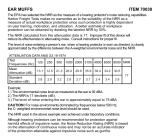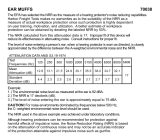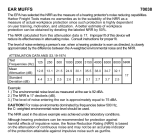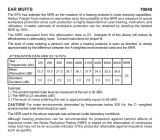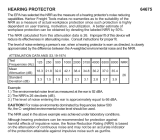
E•A•RLog® is a registered trademark of Aearo Company. Copyright 1996. First printing 1984
LIT. CODE 30306 10/96AG
HPD Attenuation At Low Audio and
Infrasonic Frequencies
In the frequency range below 50 Hz
available attenuation data appear to be
limited to only one study
10
. The authors
utilized both subjective (real-ear attenu-
ation at threshold, 35 - 500 Hz) and physi-
cal (microphone in earmuff, 1 - 500 Hz)
measurement methods. Representative
data are shown in Figure 1. They indi-
cate generally constant attenuation from
30 Hz to 100 Hz, with very limited pro-
tection or even amplification for the in-
frasonic frequencies. The data confirmed
subjective impressions also reported by
the authors.
No measurements were conducted on
insert-type protectors, but subjective re-
ports that were cited
10
suggested that a
tightly sealed earplug could provide ap-
preciable attenuation, as would also
have been predicted based upon early
theoretical studies
11
.
Although most test standards do not re-
quire testing below 125 Hz, many au-
thors have reported data in the 50 - 125
Hz range. Data from our laboratory
12
are
depicted in Figures 2, 3, and 4 for insert
semi-aural, and circumaural HPDs. The
results, extending down to the 80-Hz 1/3
octave band may be compared to the
standard test frequency results which are
also shown. All of these data, measured
in conformance with ASA STD 1, indi-
cate that the 80- and 125-Hz values are
substantially similar.
HPD Attenuation At High Audio and
Ultrasonic Frequencies
At the upper end of the audio range hear-
ing sensitivity decreases at the rate of
approximately 100 dB/octave, compared
EXTENDED FREQUENCY
DATA: SEMI-AURALS
FREQUENCY (kHz)
Figure 3
REAL-EAR ATTENUATION (dB)
STANDARD DEVIATION (dB)
NRR
air-filled pod 14
foam-filled pod 15
10
20
30
40
50
60
0
10
20
.080 .125 .250 .500 1.0 2.0 3.15 4.0 6.3 8.0 12.5 16.0
BC Limit
STD. DEV.
MEAN ATTN.
to 10 - 20 dB/octave (as frequency de-
creases) for low audio and infrasonic fre-
quencies. This fact, combined with the
relatively good inherent attenuation of
HPDs at high frequencies, makes gen-
eration of ultrasonic acoustical stimuli at
levels sufficient to be detected by hear-
ing protected test subjects very difficult.
As of this writing there do not appear to
be any studies reporting HPD perfor-
mance at ultrasonic frequencies and only
two that even discuss the range above 8
kHz
12 13
.
Representative published data
12
com-
bined with recent results from our labo-
ratory are plotted in Figures 2 - 4. HPDs
were fitted by the subjects under experi-
menter supervision. The fitting of the vi-
nyl foam earplug was an exception in
that it was tested with two distinctly dif-
ferent experimenter insertions: partial
(about 15 - 20% in the ear canal) and
standard (typical laboratory fit with 50 -
60% in the canal).
The data extend up to the 16-kHz 1/3
octave band, which includes energy to
17.8 kHz. The bold line at the bottom of
the graphs represents an estimate of the
bone conduction (BC) limits to HPD at-
tenuation
12
.
Except for the 3-flange earplug, stan-
dard-insertion foam plug, and semi-au-
ral data, the 8-kHz attenuation approxi-
mates that at 12.5 and 16 kHz. For the
two earplugs mentioned, the highest fre-
quency test data are 8 - 9 dB less than at
8-kHz. This is probably attributable to the
nearness with which the attenuation of
those plugs approaches the BC limits
which exhibit the same apparent behav-
ior in that test range.
Berger
12
also evaluated an earplug plus
earmuff combination and found that in
the frequency range from 2 - 16 kHz the
measured performance was essentially
equal to the BC limits.
Conclusions
HPD attenuation at low audio frequen-
cies (down to 50 Hz) can be estimated to
an accuracy of approximately 5 dB by
assuming it is equal to 125-Hz data. At
high audio frequencies (up to 17.8 kHz)
all HPDs tested were very effective, pro-
viding at least 32 dB noise reduction.
Thus, at those frequencies, exact esti-
mation of attenuation becomes some-
what academic.
At infrasonic frequencies earmuffs pro-
vide little or no protection and may even
amplify sound, whereas properly fitted
imperforate earplugs should provide ap-
preciable protection. No ultrasonic HPD
EXTENDED FREQUENCY
DATA: EARMUFFS
FREQUENCY (kHz)
Figure 4
REAL-EAR ATTENUATION (dB)
STANDARD DEVIATION (dB)
10
20
30
40
50
60
0
10
20
.080 .125 .250 .500 1.0 2.0 3.15 4.0 6.3 8.0 12.5 16.0
BC Limit
STD. DEV.
MEAN ATTN.
*Internal earmuff cup volume
NRR
muff #1 (liquid cushion, 190 cm
3*
)19
muff #2 (liquid cushion, 107 cm
3
)20
muff #3 (foam cushion, 336 cm
3
)25
muff #4 (foam cushion, 194 cm
3
)26
attenuation data are available, but it
would be reasonable to assume that the
general behavior observed in the high
audio range should prevail at frequen-
cies up through 32 kHz.
References and Footnotes
1. Acoustical Society of America (1975). "Method for the
Measurement of Real-Ear Protection of Hearing
Protectors and Physical Attenuation of Earmuffs,"
Standard ASA STD 1-1975 (ANSI S3.19-1974), New
York, NY.
2. International Organization for Standardization (1981).
“Acoustics Measurement of Sound Attenuation of
Hearing Protectors -Subjective Method," ISO 4869,
Switzerland.
3. Berger, E.H. - The EARLog series is available upon
request from Aearo Company.
4. von Gierke, H.E. and Nixon, C.W. (1976). "Effects of
Intense Intrasound on Man" in
Infrasound and Low
Frequency Vibration
, edited by W. Tempest
Academic Press, New York, NY, 115-150.
5. Acton, W.I. (1983). "Exposure to Industrial Ultrasound:
Hazards, Appraisal, and Control," J. Soc. Occup.
Med. 33, 107-113.
6. Acton, W.I. (1974). "The Effects of Industrial Airborne
Ultrasound on Humans," Ultrasonics 12, 124-128.
7. International Radiation Protection Association (1984).
Interim Guidelines on Limits of Human Exposure to
Airborne Ultrasound," Health Phys. 46(4), 969-974.
8. The much lower limit for 20 kHz results from the fact
that the nominal bandwidth of a 1/3 octave centered
at 20 kHz extends down to 17.8 kHz, within the upper
end of the audible frequency range.
9. The perception that occurs when environmental
noises appear to emanate from within the head or
ears.
10. Nixon, C.W., Hille, H.K. and Kettler, L.K. (1967).
"Attenuation Characteristics of Earmuffs at Low Audio
and Infrasonic Frequencies," Report AMRL-TR-67-
27, Wright-Patterson AFB, OH.
11. von Gierke, H.E. and Warren, D.R. (1953).
"Protection of the Ear From Noise: Limiting Factors,"
Benox Report, Contract N6 orl-020 Task Order 44,
Univ. of Chicago.
12. Berger, E.H. (1983). "Attenuation of Hearing
Protectors at the Frequency Extremes," in 11th Int.
Cong. on Acoustics, Paris, France, Vol. 3, 289-292.
13. Townsend, T.H. and Bess, F.H. (1973). "High
Frequency Attenuation Characteristics of Ear
Protectors," J. Occup. Med. 15(11), 888-891.


